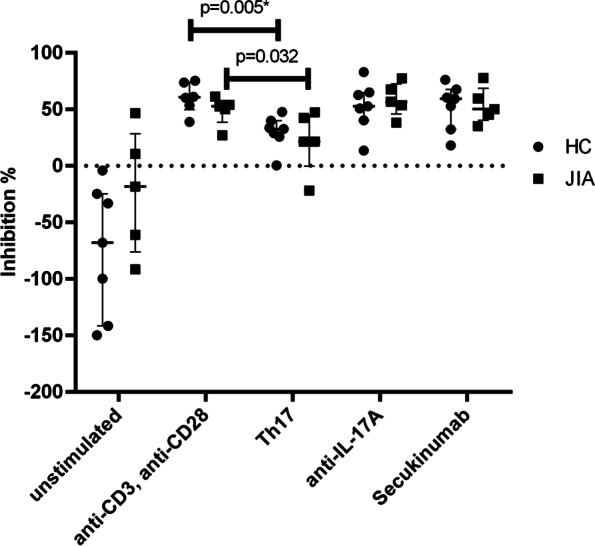Fig. 2.

Influence of stimuli on suppressive function of regulatory T cells on peripheral blood mononuclear cells. Isolated regulatory T cells (Treg) and autologous Peripheral blood mononuclear cells (PBMC) were co-cultured in different stimuli. The suppressive function of Treg on PBMC as inhibition in % was calculated as 1-(proliferation of PBMC in 1:1 Co-Culture with isolated Treg × 100) ÷ (proliferation of PBMC in 1:0 Culture) using Carboxyfluorescein-succinimidyl-ester-(CFSE)-assay, assessed by flowcytometry after 5 days of culture. Values are shown in percentage (median and interquartile ranges). As stimuli were used: unstimulated = none; anti-CD3/CD28 as positive control; Th17 = anti-CD3/CD28 + IL-1β + IL-6 + IL-23 + TGFβ; anti-IL17A = anti-CD3/CD28 + laboratory IL-17A-antibody; Secukinumab = anti-CD3/28 + Secukinumab. N = 7 for each stimulus in healthy controls (HC), except for anti-CD3/anti-CD28 (n = 6) and n = 5 for each stimulus in Juvenile Idiopathic Arthritis (JIA). For stimuli comparison all stimuli were compared with anti-CD3/anti-CD28, which served as positive control. Groups as well as stimuli were compared for differences with Mann–Whitney-U-test. Mitigated inhibitory function was seen in Th17 environment in both groups. Difference between positive control and Th17-inducing cytokine environment in HC was significant (p = 0.005, marked with *) after Bonferroni correction was applied. Difference between negative control (= unstimulated) and positive control in HC was statistically significant as well (p = 0.001, not marked)
